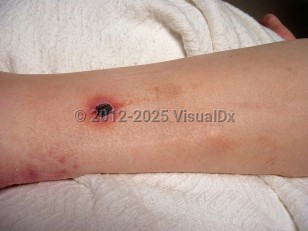Paecilomyces lilacinus infection
Alerts and Notices
Important News & Links
Synopsis

The fungus Paecilomyces lilacinus is most frequently encountered as an opportunistic pathogen in immunosuppressed patients.
This organism has been associated with a wide variety of infections. Clinical symptoms can be nonspecific, and it is not usually possible to distinguish infection due to Paecilomyces from infection caused by other fungal organisms based on physical exam alone. When the organism is identified in nonsterile sites, distinguishing colonization from active infection can be difficult.
Paecilomyces can be isolated from many environments but is most commonly found in soil and sewage, although it has been isolated from saunas and in laboratories (airborne contaminant) as well.
Skin manifestations include plaques, nodules, or pustular lesions. Lesions may be solitary or disseminated. A sporotrichoid pattern can be seen. Cellulitis has also been reported. This organism has caused sternal wound infections, sinus infections, and osteomyelitis.
Especially devastating is infection of ocular structures, with cases of keratitis and endophthalmitis reported. Very poor outcomes with this infection are common, including enucleation of the affected eye and loss of vision. A history of intraocular lens implantation and recent steroid use are risk factors for this infection.
This organism has been associated with a wide variety of infections. Clinical symptoms can be nonspecific, and it is not usually possible to distinguish infection due to Paecilomyces from infection caused by other fungal organisms based on physical exam alone. When the organism is identified in nonsterile sites, distinguishing colonization from active infection can be difficult.
Paecilomyces can be isolated from many environments but is most commonly found in soil and sewage, although it has been isolated from saunas and in laboratories (airborne contaminant) as well.
Skin manifestations include plaques, nodules, or pustular lesions. Lesions may be solitary or disseminated. A sporotrichoid pattern can be seen. Cellulitis has also been reported. This organism has caused sternal wound infections, sinus infections, and osteomyelitis.
Especially devastating is infection of ocular structures, with cases of keratitis and endophthalmitis reported. Very poor outcomes with this infection are common, including enucleation of the affected eye and loss of vision. A history of intraocular lens implantation and recent steroid use are risk factors for this infection.
Codes
ICD10CM:
B49 – Unspecified mycosis
SNOMEDCT:
3218000 – Mycosis
B49 – Unspecified mycosis
SNOMEDCT:
3218000 – Mycosis
Look For
Subscription Required
Diagnostic Pearls
Subscription Required
Differential Diagnosis & Pitfalls

To perform a comparison, select diagnoses from the classic differential
Subscription Required
Best Tests
Subscription Required
Management Pearls
Subscription Required
Therapy
Subscription Required
References
Subscription Required
Last Reviewed:05/08/2017
Last Updated:05/08/2017
Last Updated:05/08/2017
Paecilomyces lilacinus infection

